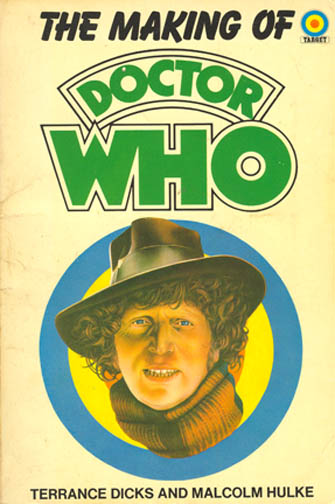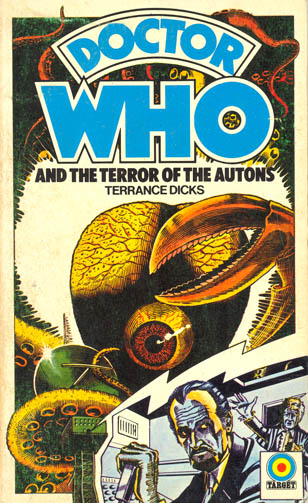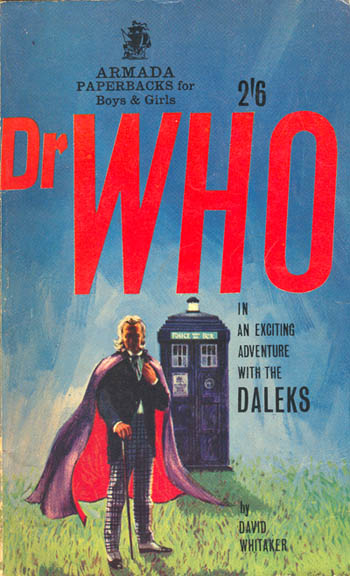As an American kid in the 70s, Dr. Who was one of those mysterious legends that I read scant bits about but could never see. I knew that it was a long-running British science fiction show, but that was about it. The confusion only grew when I would see pictures of different actors listed as The Doctor. Were these misprints? How could the character get younger over time rather than older? I was really dying to see this show, but for some strange reason, it was never syndicated in the
 My interest was further heightened when I stumbled across a book called The Making of Dr. Who at my local comic/used book store in the fall of ‘77. Although it was a slim volume aimed at the pre-teen market Dr. Who primarily served, I found it a well-spring of valuable knowledge on this mysterious TV show from across the pond. The book explained the whole production history, from its roots as an educational show on history and science to its transformation into a monster-filled adventure show for all ages. The book also explained how The Doctor had the ability to change his physical form whenever he became seriously ill. This was a great excuse when they had to hire a new actor to fill the role, but it also allowed producers the opportunity to re-invent the character and the very nature of the show every few years, keeping it fresh and adapting to changing tastes.
My interest was further heightened when I stumbled across a book called The Making of Dr. Who at my local comic/used book store in the fall of ‘77. Although it was a slim volume aimed at the pre-teen market Dr. Who primarily served, I found it a well-spring of valuable knowledge on this mysterious TV show from across the pond. The book explained the whole production history, from its roots as an educational show on history and science to its transformation into a monster-filled adventure show for all ages. The book also explained how The Doctor had the ability to change his physical form whenever he became seriously ill. This was a great excuse when they had to hire a new actor to fill the role, but it also allowed producers the opportunity to re-invent the character and the very nature of the show every few years, keeping it fresh and adapting to changing tastes.
At the time, Tom Baker was playing Dr. Who in his fourth incarnation. Baker would become the most famous Doctor, with his trademark floppy hat and flowing scarf standing as icons for the series. While he was certainly the most unique of the Doctors, I was more interested in his predecessor, Jon Pertwee. Although primarily a comedic actor, Pertwee was a dashing figure with an elegant pile of curly silver locks and an athletic stride. He chose to play The Doctor as an eccentric James Bond, wearing smoking jackets and frilly shirts while beating up bad guys with his Venusian Akito. Further solidifying his Bondian mystique was the fact that he spent most of his adventures on Earth, working for a group called U.N.I.T. (United Nations Intelligence Taskforce). This group fought aliens bent on taking over the planet. Who knew so many aliens would choose to start their wars in quarries near
 Now I was dying to see this program. I wrote to my local independent TV station WBFF-TV Channel 45, but they informed me the show was not available in syndication. My next best bet was to acquire the novelizations based on the TV serials, but since they were published in
Now I was dying to see this program. I wrote to my local independent TV station WBFF-TV Channel 45, but they informed me the show was not available in syndication. My next best bet was to acquire the novelizations based on the TV serials, but since they were published in
 For the next year and a half, Dr. Who books were my only access to the show. Once the guy who ran the book store knew I was into Dr. Who, he even found some collectibles for me, including the original Dr. Who novel from 1964 and several annuals (the Brits were big on doing annuals of popular children’s programs). I loved all this stuff, but I wanted to see the real thing. Finally, in September 1979, the first four seasons of the Tom Baker era were syndicated in the
For the next year and a half, Dr. Who books were my only access to the show. Once the guy who ran the book store knew I was into Dr. Who, he even found some collectibles for me, including the original Dr. Who novel from 1964 and several annuals (the Brits were big on doing annuals of popular children’s programs). I loved all this stuff, but I wanted to see the real thing. Finally, in September 1979, the first four seasons of the Tom Baker era were syndicated in the
 I still held the show in great affection during the 80s and was thrilled when Maryland Public Television started showing the old Dr. Who serials commercial free, as they were intended to be aired. By the late 80s, I was even able to see the shows with my favorite Doctor: Jon Pertwee. Ironically, while the 80s saw a spike in Dr. Who’s popularity in the states, the show was struggling for survival in
I still held the show in great affection during the 80s and was thrilled when Maryland Public Television started showing the old Dr. Who serials commercial free, as they were intended to be aired. By the late 80s, I was even able to see the shows with my favorite Doctor: Jon Pertwee. Ironically, while the 80s saw a spike in Dr. Who’s popularity in the states, the show was struggling for survival in
Fox attempted a pilot for a new Dr. Who show in the mid-90s. It wasn’t bad, and it even bore some resemblance in style to the current show, but it was just a little bland. A regular series was never made. After being such a fixture of British television for so long, it seemed strange that The Doctor would be forever gone. Then in 2005, the BBC found a way to make the old hero work in a new century, and I’m mighty glad they did.




No comments:
Post a Comment